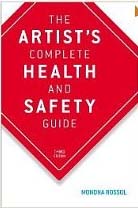Health hazards from nuno-felting acid-dyed silks with bare hands
Name: Cheryl
—ADVERTISEMENTS—

Includes detailed information about hazardous dyes and other hazardous art materials
The Artist's Complete Health and Safety Guide
by Monona Rossol

MicroThin Surgical Gloves
Try to find true surgical gloves, which come in more sizes (including half sizes such as 7 or 7.5) and allow more sensitivity than cheaper exam gloves.
Books that explain how to use Lanaset dyes

Shibori: Creating Color and Texture On Silk
by Karren Brito
Color in Spinning
by Deb Menz
mixing your own colors with Lanaset dyes
Country or region: Canada
Message: Paula - firstly - love your website. I hope that I am not bothering you with a question already answered, but I couldn't find anything on the site. I work with acid dyes on silk for nuno-felting. When I dye my silks (usually using the microwave) and then rinse them it appears that I have rinse off any excessive dye. However, once I start the felting process it creates some dye runoff. My question is twofold - firstly, since I use olive oil soap for felting, I am wondering if this causes the dye runoff, and secondly, since I am using my bare hands for felting (it's important to be able to "feel" the work as it progresses), am I creating a health hazard for myself in this work. Thank you in advance if you're able to answer this question!
The dye runoff may be caused by the change in pH due to the soap, by a higher temperature of water, by any changes in hardness of the water (use either distilled water or the water softener sodium hexametaphosphate when dyeing and rinsing out after dyeing), or, probably to a lesser extent, by the soaping action of your olive oil soap.
You are exposing yourself to the acid dyes when the dyes come off into the water your hands are in, during felting. How much of a problem this is depends on the individual dye. It's unfortunate that gloves interfere with your felting procedure. I always tell people to wear gloves when working with dyes, because there's usually so little sacrifice in doing so that it would be crazy not to, even for very small possibilities of risk. It's a harder call when gloves are a major problem for you.
There are three directions you can take in confronting this problem:
1. Find more comfortable gloves that can be used without impairing your ability to felt correctly—would the more expensive gloves actually used by surgeons be better than the cheap loose exam gloves that we usually use for dyeing?
2. Use a more washfast dye. Switch from your current acid dyes to Lanaset dyes, which are far more washfast. Lanaset dyes can be washed at 140°F (60°C) without loss of color, unlike most acid dyes, which we are warned to never wash above 104°F (40°C). You will probably see much less dye coming out into your soapy water. (Lanaset dyes are sold in Canada by Maiwa Handprints under the brand name "Telana". See my page, "Sources for Dyeing Supplies Around the World", for contact information for this and other dye suppliers mentioned here.)
3. Be very careful to avoid carcinogenic or toxic dyes.
The safest acid dyes are the certified food colorings, which in some cases provide good results when used as acid dyes. See my page, "Using Food Coloring as a Textile Dye for Protein Fibers". You can feel quite safe in using these thoroughly-tested dyes with your bare hands.
Some acid dyes are known to be carcinogenic. Other acid dyes are not carcinogenic, but we like to act as though they all are, in case there might be any future discoveries of dangers not yet known. Over the years we have found that many acid dyes and direct dyes that were formerly (until around 1980) considered safe enough to be packaged for home use by highly inexpert dyers are actually quite dangerous when used carelessly. Since home users' exposure was much lower than that of dye factory employees, we can hope that the home users' rate of developing cancer in most cases was much less than among the industrial employees, who were observed to have a very significantly increased risk of bladder cancer. The risk of working with a carcinogenic dye is directly related to the amount of exposure.
The dyes of particular concern, most of which have been phased out from home-use dyes, are those based on the chemicals benzidine, o-tolidine, and o-dianisidine. I've written about the safety hazards of those dyes in the past; for more information see my other pages:
and
"'I am interested in asking other people who use Dupont Dye if they have had any trouble with bladder cancer'" for more details.
Acid dyes based upon the aromatic amines benzidine, o-tolidine, and o-dianisidine include Colour Index acid orange 45, acid orange 63, acid red 85, acid red 89, acid red 97 Scarlet G, acid yellow 42, acid yellow 44, acid red 114, and acid red 167,
While dyes based upon these aromatic amines are known to be hazardous, there are also some other dyes that are not in this category and yet which may be equally harmful. You will need to gather information about each individual dye color you use without gloves.
Some brands of acid dyes are well-identified as to which specific dyes are used in them. These include the WashFast Acid Dyes (you can buy these in Canada from Maiwa Handprints), Jacquard Acid Dyes, and Dharma Trading Company's new line of Dharma Acid Dyes. While the exact contents of any of the pre-mixed colors are never revealed, you can ask whether their contents are made up only of the pure unmixed single-hue dyes in the same dye line, which are identified properly by the suppliers by their generic Colour Index names. The generic names allow you to find additional information, in case you do not fully trust a particular MSDS (some MSDS pages are less detailed and alarming than others for the very same chemical). Other acid dyes are not identified at all, so you cannot know whether or not they contain potential carcinogens; you will never know what dyes you're working with if you use Rit dyes or Cushing dyes, for example.
Always ask for an MSDS page for every single dye color you buy, and do not buy dyes from suppliers that fail to supply this information on request. Unfortunately, many MSDS pages have nothing more useful than "not available" entered into very important sections of information, even in some cases when negative information is available. MSDS pages can be confusing. It's important to know the Colour Index names of all of the dyes you are using, in order to be able to obtain further safety information. You can ask your supplier to list which pre-mixed dye colors are free of any of a list of dye names you are trying to avoid, without compromising their trade secrets.
For example, one MSDS for Rhodamine B, a highly popular hot pink fluorescent dye included in many lines of dye (it's sold as Jacquard's 620 Hot Fuchsia acid dye, and as WashFast Acid Rhodamine Red 370) , gives it a health rating of "3 - Severe (Cancer Causing)" (on a scale of 0 for good and 4 for bad) (see JTBaker), while another one (from ScienceLab) says only "CARCINOGENIC EFFECTS: Not available", and an MSDS [PDF] for the same dye from the WashFast Acid Dye line says "NO KNOWN HAZARDOUS INGREDIENTS PRESENT." An MSDS from the chemical supplier Sigma Aldritch gives this same dye a health hazard rating of 2 (on the scale of 0 to 4) and says, "Harmful if swallowed; causes severe eye damage; harmful to aquatic life; wear protective gloves/eye protections/face protection." It's not at all clear from these conflicting MSDS pages just how hazardous Rhodamine B may be; I would use it while wearing reliable gloves and following other safety precautions, but I would never use it without gloves.
If you can, find higher-quality gloves that allow you to wear them while felting, or switch to safe food coloring or to more washfast Lanaset/Telana dyes; if that is impossible, please be careful to avoid the more hazardous dyes. I'd be happy to help you try to track down more information on individual dyes.
(Please help support this web site. Thank you.)
(Please help support this web site. Thank you.)
Posted: Friday - July 06, 2012 at 10:28 AM
Follow this blog on twitter here.
Quick Links
- All About Dyes & Dyeing Top -
- Top of this blog -
- FAQ -
- The Dye Forum -
- How to Tie Dye - How to Batik -
- Books - Toys - Plants -
- Top of this blog -
- FAQ -
- The Dye Forum -
- How to Tie Dye - How to Batik -
- Books - Toys - Plants -
More in this category:
- -
Statistics
Total entries in this blog:
Total entries in this category:
Published On: Aug 29, 2012 02:49 PM
Total entries in this category:
Published On: Aug 29, 2012 02:49 PM